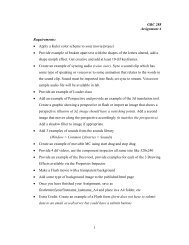Introducing Financial Accounting - CCSN Computer Graphics Program
Introducing Financial Accounting - CCSN Computer Graphics Program
Introducing Financial Accounting - CCSN Computer Graphics Program
You also want an ePaper? Increase the reach of your titles
YUMPU automatically turns print PDFs into web optimized ePapers that Google loves.
wiL27041_ch01_002-047.indd Page 38 10/7/10 2:41:38 PM user-f499 /Volumes/204/MHBR211/wiL27041_disk1of1/0073527041/wiL27041_pagefiles<br />
38 Chapter 1 <strong>Introducing</strong> <strong>Financial</strong> <strong>Accounting</strong><br />
Problem 1-6A<br />
Preparing a statement of<br />
cash flows<br />
P2<br />
Check Cash balance, Dec. 31,<br />
2011, $3,500<br />
Problem 1-7A<br />
Analyzing effects of transactions<br />
C4 P1 P2 A1<br />
Check (2) Ending balances: Cash,<br />
$9,200; Expenses, $3,500; Notes<br />
Payable, $250,000<br />
(3) Net income, $8,500<br />
Problem 1-8A<br />
Analyzing transactions and<br />
preparing financial statements<br />
C4 P1 P2<br />
x<br />
e cel<br />
mhhe.com/wildFAF3e<br />
Following is selected financial information of Trimark for the year ended December 31, 2011.<br />
Cash used by investing activities . . . . . . . . . $(3,000)<br />
Net increase in cash . . . . . . . . . . . . . . . . . . 200<br />
Cash used by financing activities . . . . . . . . . (3,800)<br />
Cash from operating activities . . . . . . . . . . 7,000<br />
Cash, December 31, 2010 . . . . . . . . . . . . . . 3,300<br />
Required<br />
Prepare the 2011 statement of cash flows for Trimark Company.<br />
Miranda Right started Right Consulting, a new business, and completed the following transactions during<br />
its first year of operations.<br />
a. M. Right invests $60,000 cash and office equipment valued at $30,000 in the company in exchange for<br />
common stock.<br />
b. The company purchased a $300,000 building to use as an office. Right paid $50,000 in cash and signed<br />
a note payable promising to pay the $250,000 balance over the next ten years.<br />
c. The company purchased office equipment for $6,000 cash.<br />
d. The company purchased $4,000 of office supplies and $1,000 of office equipment on credit.<br />
e. The company paid a local newspaper $1,000 cash for printing an announcement of the office’s opening.<br />
f. The company completed a financial plan for a client and billed that client $4,000 for the service.<br />
g. The company designed a financial plan for another client and immediately collected an $8,000 cash fee.<br />
h. The company paid $1,800 cash for dividends.<br />
i. The company received $3,000 cash as partial payment from the client described in transaction f.<br />
j. The company made a partial payment of $500 cash on the equipment purchased in transaction d.<br />
k. The company paid $2,500 cash for the office secretary’s wages for this period.<br />
Required<br />
1. Create a table like the one in Exhibit 1.9, using the following headings for the columns: Cash; Accounts<br />
Receivable; Office Supplies; Office Equipment; Building; Accounts Payable; Notes Payable; Common<br />
Stock; Dividends; Revenues; and Expenses.<br />
2. Use additions and subtractions within the table created in part 1 to show the dollar effects of each transaction<br />
on individual items of the accounting equation. Show new balances after each transaction.<br />
3. Once you have completed the table, determine the company’s net income.<br />
J. D. Simpson started The Simpson Co., a new business that began operations on May 1. The Simpson Co.<br />
completed the following transactions during its first month of operations.<br />
May 1 J. D. Simpson invested $60,000 cash in the company in exchange for common stock.<br />
1 The company rented a furnished office and paid $3,200 cash for May’s rent.<br />
3 The company purchased $1,680 of office equipment on credit.<br />
5 The company paid $800 cash for this month’s cleaning services.<br />
8 The company provided consulting services for a client and immediately collected $4,600 cash.<br />
12 The company provided $3,000 of consulting services for a client on credit.<br />
15 The company paid $850 cash for an assistant’s salary for the first half of this month.<br />
20 The company received $3,000 cash payment for the services provided on May 12.<br />
22 The company provided $2,800 of consulting services on credit.<br />
25 The company received $2,800 cash payment for the services provided on May 22.<br />
26 The company paid $1,680 cash for the office equipment purchased on May 3.<br />
27 The company purchased $60 of advertising in this month’s (May) local paper on credit; cash<br />
payment is due June 1.<br />
28 The company paid $850 cash for an assistant’s salary for the second half of this month.<br />
30 The company paid $200 cash for this month’s telephone bill.<br />
30 The company paid $480 cash for this month’s utilities.<br />
31 The company paid $1,200 cash for dividends.<br />
Required<br />
1. Arrange the following asset, liability, and equity titles in a table like Exhibit 1.9: Cash; Accounts<br />
Receivable; Office Equipment; Accounts Payable; Common Stock; Dividends; Revenues; and Expenses.









